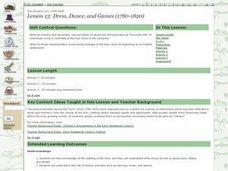Curated OER
Stravinsky and the Rite of Spring
In this music activity, students answer 20 questions about an extract from "Stravinsky and the Rite of Spring." Students also write an essay discussing a given quote about the extract.
Curated OER
Rooster's Night Out
Mitch Weiss and Martha Hamilton's Rooster's Night Out, a retelling of a classic Cuba folktale, launches a cross-curricular study of Cuban cultural traditions. Class members draw the characters from the book, participate in math and...
Curated OER
On Stage Tonight . . .
Eleventh graders explore the World Wide Web for information concerning the period known as "The Harlem Renaissance." They study the contributions made by African Americans in the areas of literature, art, and music during this period in...
Curated OER
New england (1780-1820): Dress, Dance and Games
Pupils examine and discuss nineteenth century clothing and compare it to contemporary styles. After writing paragraphs describing the clothing styles, they play games from the period. For homework, they create their own games to play the...
Curated OER
Favourite Authors
Students discuss in open forum their favorite author and give reasons to back up their decisions. Students choose from a variety of writing prompts. Students prepare a series of questions that they might ask their favorite authors if...
Curated OER
Street Language
Students consider the impact of language. In this literacy lesson, students read an article about literary classics being rewritten in "youth speak" (the article is not included). Students read and discuss the article.
Curated OER
"Bees and Ants"
First graders participate in a variety of activities related to bees and ants.
Curated OER
Why We Communicate
Students identify the three common reasons for communication: information, persuasion, and entertainment. They create media messages for different purposes and develop a purpose of message shapes and how it helps shape the message.









